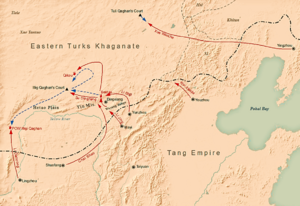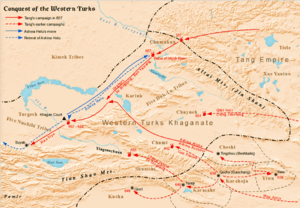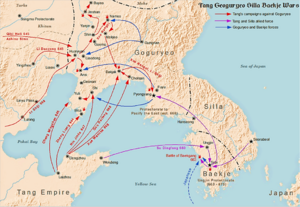Su Dingfang facts for kids
Su Dingfang (591–667) was a very important military general during China's Tang Dynasty. His formal name was Su Lie, but he was known by his courtesy name, Dingfang. He is famous for destroying the Western Turkic Khaganate in 657, which greatly expanded the Tang Empire's borders to the west. He also played a key role in conquering Baekje in 660. Su Dingfang was born in Wuyi, which is in modern-day Hengshui, Hebei province.
Contents
Early Life and Battles
Su Dingfang was born in 591, when Emperor Wen ruled the Sui Dynasty. Later, when Emperor Yang was in charge, many farmers rebelled across the empire. Su Dingfang's father, Su Yong, led a local group of fighters to stop these rebels.
When Su Dingfang was a teenager, he often fought at the front of his father's troops. After his father died, Su Dingfang took over the group and continued fighting the rebels. He was known for defeating and killing a major rebel leader named Zhang Jincheng. He also defeated another rebel general, Yang Gongqing.
Su Dingfang later joined a rebel leader named Dou Jiande. Dou's general, Gao Yaxian, treated Su Dingfang like his own son. In 621, Dou Jiande was defeated by the Tang Dynasty general Li Shimin (who later became Emperor Taizong). After this, Gao Yaxian and other former generals rebelled again, supporting Liu Heita. Su Dingfang also fought with Liu. After Gao died in battle and Liu was defeated in 623, Su Dingfang returned home.
Sometime after 626, Su Dingfang became a military officer under the famous general Li Jing. In 629–630, Li Jing led a campaign against the Eastern Turkic Khaganate. In a major battle where Li Jing defeated the Jiali Khan, Su Dingfang was the forward commander. After this victory, Su Dingfang was promoted to a mid-level officer.
Service Under Emperor Gaozong
Not much is known about Su Dingfang's career during Emperor Taizong's rule. But by 655, during the reign of Emperor Gaozong (Emperor Taizong's son), Su Dingfang was still at the same rank he had achieved earlier. That year, he helped General Cheng Minzhen in a campaign to bother the borders of Goguryeo.
Later in 655, Emperor Gaozong sent General Cheng Zhijie to lead an army against the Western Turkic Khaganate's leader, Ashina Helu. Ashina Helu had been a Tang ally but had broken away. Su Dingfang served under Cheng in this campaign. Cheng's army had some early success against the Western Turks' allied tribes.
Around early 657, Cheng's forces met the main Western Turk army. Su Dingfang led the front troops, and they won the first fights. However, Cheng's deputy, Wang Wendu, was jealous. Wang ordered the army to form a rectangle with supplies in the middle, instead of attacking right away as Su suggested. Wang even faked an order from the Emperor to take command. Su warned Cheng that Wang's actions would tire out their troops and that the order was fake. He told Cheng to arrest Wang and attack. But Cheng refused. Later, Wang also stole property from some Western Turk people who surrendered, even though Su objected. Eventually, Wang was found out for faking the order, but he was only demoted.
Conquering the Western Turks
In spring 657, Emperor Gaozong launched another campaign against the Western Turks. This time, Su Dingfang was in charge. He had help from other generals and troops from Tang's ally, Huige. Su Dingfang first attacked the Chumukun tribe and defeated them.
Su Dingfang then faced Ashina Helu's army of nearly 100,000 men, while he had less than 20,000. Ashina Helu thought he could easily crush Su's smaller army and ordered a charge. But he couldn't break through Su's infantry, who used long spears. Su then counterattacked with his cavalry, defeating Ashina Helu and capturing or killing tens of thousands of his soldiers.
The next day, as Su continued to advance, the leaders of five Western Turk tribes surrendered. Ashina Helu fled. Su kept chasing Ashina Helu, even through snowstorms. His generals wanted to stop, but Su said Ashina Helu would be surprised if they kept going, making him easier to catch. Su joined forces with other Tang allies and made a surprise attack on Ashina Helu, defeating him again.
Ashina Helu fled to Shi (modern Tashkent), a kingdom that was allied with the Western Turks. But Shi did not want to be attacked by Tang forces, so they captured Ashina Helu and handed him over to the Tang army. This meant the independent Western Turkic Khaganate was no more.
When Su Dingfang brought the captured Ashina Helu to Emperor Gaozong, the Emperor spared Ashina Helu's life. He promoted Su Dingfang to a major general and gave him the title Duke of Xing. Su's son, Su Qingjie, was also given a title.
Campaign Against Duman
In 659, a tribe called Sijie, led by Duman, rebelled against Tang rule. Other kingdoms near modern Kashgar also joined Duman. Their combined forces quickly defeated the Tang ally, Yutian.
In winter 659, Emperor Gaozong sent Su Dingfang to fight Duman. When Su arrived near Duman's army, he chose 10,000 foot soldiers and 3,000 cavalry and launched a surprise attack. Duman was caught off guard. After Su defeated him, Duman had to retreat inside his city. Su surrounded the city, and Duman surrendered.
In spring 660, Su took Duman to Luoyang, where Emperor Gaozong was. Some officials wanted Duman to be executed. But Su asked the Emperor to spare Duman, explaining that he had promised Duman his life before he surrendered. Emperor Gaozong agreed to honor Su's promise and spared Duman.
Campaign Against Baekje
Su Dingfang remained very active. Also in spring 660, Tang's ally on the Korean Peninsula, Silla, asked for help because Baekje was attacking them. Emperor Gaozong put Su Dingfang in charge of a large army and navy of 100,000 soldiers to attack Baekje, working with Silla's King Muyeol.
In summer 660, Su Dingfang sailed from Chengshan (modern Weihai) across the Yellow Sea to Baekje. Baekje forces tried to stop the Tang army from landing, but they failed. Tang forces then directly attacked Baekje's capital, Sabi, and surrounded it. Baekje's King Uija and his crown prince fled north. As they left, the King's second son, Buyeo Tae, declared himself king. However, the crown prince's son, Buyeo Munsa, pointed out that if they repelled the Tang, Tae would likely kill them. So, Munsa surrendered, and many people followed him. Tae was then forced to surrender, along with King Uija and the crown prince.
Emperor Gaozong ordered that Baekje's land become part of the Tang Empire. In winter 660, Su Dingfang presented the captured Baekje leaders to Emperor Gaozong in Luoyang. The Emperor released King Uija and the others. However, after this victory, some of Su's soldiers treated the Baekje people unfairly. This caused the Baekje people to start fighting back, led by King Uija's son, Buyeo Pung. This resistance was not fully stopped until 663.
Later Years
In winter 660, Emperor Gaozong ordered Su Dingfang and other generals to attack Baekje's ally, Goguryeo. By fall 661, Su had surrounded Goguryeo's capital, Pyongyang. However, by spring 662, after one of his generals was defeated and killed, and facing severe snowstorms, Su could not capture Pyongyang. He was forced to withdraw his forces.
In summer 663, Tibet launched a major attack against the Tang ally, Tuyuhun. Emperor Gaozong sent Su Dingfang to lead an army to help Tuyuhun. There are no clear records of a Tang victory, but also no records of Tibetans winning against Tuyuhun at that time. Su Dingfang died in 667.




